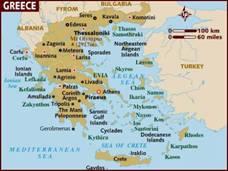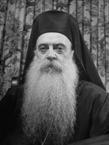National Churches: Greece and Constantinople
GREECE AND CONSTANTINOPLE
 Geography:
Geography:
Greece is a small country, a peninsula and a group of islands in the Mediterranean. Its capital is Athens, home of the Parthenon and cradle of democracy. Its highest peak is Mt. Olympus, where the gods were to have dwelt. Since no point is more than 85 miles from the sea, Greece has a Mediterranean climate – cool, wet winters and hot, dry summers. The whitewashed homes with thick tile roofs are a product of the climate. Much of the land is stony and grows only thorny shrubs, but the valleys are fertile, growing cotton, grapes, lemons, olives. Look at pictures in an atlas or library book; a map is included in the next few pages but is too small to be of great value.
Turkish Rule:
In 1453, Constantinople fell to the Turks. Review the lesson if need be. For 400 years, Greece and the Balkans were ruled by the Ottoman Empire. The Greeks were constantly caught in the crossfire between the Turks and the Europeans, especially Venetians. (Remember their role in the sack of Constantinople?)
The Turks did follow the practice of the Koran allowing the Orthodox to continue their religious observances. But, they recognized only the Patriarch of Constantinople as the head of the Orthodox Church, regardless of the nationality of the Orthodox. Thus, the position of Patriarch was both an exalted and a precarious one; he depended on the good will of the Moslem rulers to hold office. He was also required to give a sizeable monetary donation to the Sultan upon appointment to the office of Patriarch. Thus there were frequent changes of Patriarch and a violent end for many Patriarchs. In fact, during the Turkish rule, only 21 of the 159 Patriarchs died a natural death! After Haggia Sophia was turned into a mosque, the Patriarch also had to move from church to church. But, through it all, the Patriarchate of Constantinople preserved the Orthodox Church.
As the Ottoman Empire declined in the 17th century, they recruited Greeks to assist their Empire as bankers, shipbuilders, merchants, and even in the government. These resettled Greeks lived in the lighthouse quarter of the old city, the Phanar, and were known as Phanariotes. There the Patriarchate relocated in 1601 in the Church of St. George, where it resides to this day. Here, among the Phanariotes, emerged the “Philiki Hetairia,” or “Society of Friends.” This movement slowly and secretly prepared to fight for Greek independence by setting up an intricate network of messengers, training troops, and amassing funds. The Turks themselves had set up the means for Greek independence.
St. Cosmas Aiotolos:
About 250 years ago there lived in the land of Greece a monk named Cosmas Aitolos. Cosmas lived for 17 years in the monastery on Mt. Athos. But, God told Cosmas to leave the monastery. The Greeks had been ruled for many, many years by the Moslem Turks. Many had forgotten the Lord Jesus. God asked Cosmas to bring His people back to Him.
Cosmas traveled for 20 years all around the land of Greece. He built schools and churches and gave people crosses and icons. Soon, people heard of this holy man and came to hear him preach. Wonderful things would happen while Cosmas was teaching – a tailor with a withered hand was healed, a rich noble could hear again.
Many times Cosmas had to preach outdoors because of the huge crowds. They would stick a large cross in the ground where Cosmas was going to preach to let people know. But, one day, a Turkish soldier pulled out one of the crosses. Suddenly the earth shook and the soldier fell down foaming at the mouth. When he woke up, the soldier knew he had been punished for taking down the cross. He put it back up.
But, many of the people, especially of the Jews and Turks, did not want Cosmas to keep preaching about Jesus. So, the ruler ordered Cosmas to be killed. The soldiers took the old monk and killed him by tying his neck to the trunk of a tree. Cosmas is also called “Equal to the Apostles” because he brought the Greek people back to the Lord.
Greek Independence:
With the late 1700s, came an era of nationalism all over Europe. America declared her independence in 1776 and France in 1798. The Greeks were watching…and waiting for their own opportunity. By 1814, the Philiki Hetairia was a formidable political organization, ready for revolution. On the Feast of the Annunciation, 1821, the revolt began, and soon all Greece was in revolt. Americans even came to help fight in the Greek War for Independence, just as the French had helped fight in ours.
The Turks were outraged! How dare the Greeks rise in rebellion! They murdered countless bishops, priests, nuns, and citizens; on the island of Chios alone, 40,000 Greeks were put to death. Patriarch Gregory V was seized as he celebrated the Paschal Liturgy and hanged. But, his martyrdom only spurred the Greeks on to greater courage.
Finally, after three years, Europe began to support the Greeks. England offered a loan. England, France, and Russia sent battleships and won the decisive Battle of Navarino in 1827, a total defeat for the Turks. In September, 1829, the Turks recognized the independence of Greece, although only the southern part. It would be another 75 years before the northern provinces, the Balkans, and the Mediterranean islands would be freed.
Greek Church in America:
The earliest Greeks in America came as servants, farm laborers, to Florida. They were treated very badly and many escaped to St. Augustine. By 1793 there were 100 Greek names as citizens of St. Augustine. But, everything changed with the Greek Revolution…
 Soon, Greek people were coming to our country – cotton merchants in the South, sponge divers in Florida – all wanted to have Orthodox Christian churches to worship in. They built churches and priests came from Greece. Holy Trinity Chapel in New Orleans was the first Greek Orthodox Church in America, but it was not alone for long. In the 1890s even larger numbers of Greek immigrants came and by 1920 there were 50 Greek parishes in the US. But, there was no bishop – no shepherd to lead the Greek people in America. Power struggles in the new country of Greece were replayed in America, with each immigrant faction supporting a different political faction back in Greece. Each church in each town just did what its priest thought was right. People argued; no one decided.
Soon, Greek people were coming to our country – cotton merchants in the South, sponge divers in Florida – all wanted to have Orthodox Christian churches to worship in. They built churches and priests came from Greece. Holy Trinity Chapel in New Orleans was the first Greek Orthodox Church in America, but it was not alone for long. In the 1890s even larger numbers of Greek immigrants came and by 1920 there were 50 Greek parishes in the US. But, there was no bishop – no shepherd to lead the Greek people in America. Power struggles in the new country of Greece were replayed in America, with each immigrant faction supporting a different political faction back in Greece. Each church in each town just did what its priest thought was right. People argued; no one decided.
Finally, in 1930 Archbishop Athenagoras was elected by the bishops of Greece to be the first bishop of the Greek Church in America. He was a tall man with a long, flowing beard. He brought the churches together, built schools, started new churches. The Greek people in America had a leader for their flock. He founded new parishes, built schools and Holy Cross Seminary, and even began mission parishes in South America. Bishop Athenagoras loved his people as a shepherd and cared for them until he died about 50 years ago.
After the death of Athenagoras in 1948, Archbishop Michael assumed leadership of the Greek Orthodox in America. He joined the World Council of Churches, a bold move that brought Orthodoxy to national attention. He was succeeded by Archbishop Iakavos. He has worked to help the Greek Church effectively serve both its immigrant and its American-born members.
Cultural Tradition:
Food: In recent years, Greek food has become popular well beyond the Greek community. Brainstorm some foods the students enjoy – baklava, gyros, spanikopita, stuffed grape leaves, moussaka, Greek salad. Take a field trip after class to a Greek restaurant?
Dance: Greek music has an unusual 7-beat rhythm and Greek dancing is well-known even to non-Orthodox. Visit the next Greek festival to feast your eyes.
Language: Greek is everywhere! Fraternities, sororities, alphas and betas abound. Look for them this week as you go through your daily activities. Do you enough Greek letters to at least sound out the names on the icons? If not, try to learn; this skill alone will be essential as you visit other churches or travel in Europe later in life.
Clothing: Have one of our Greek members bring some outfits to try on; you see these regularly in use at the Greek festivals.
Quiz Questions:
- Identify these people: Athenagoras, Cosmas, Gregory, Iakovos.
- Identify these things: Ottoman Empire, Phanariotes, Philiki Hetairia, Battle of Navarino, spanikopita
- Locate Greece and its capital Athens on a map.